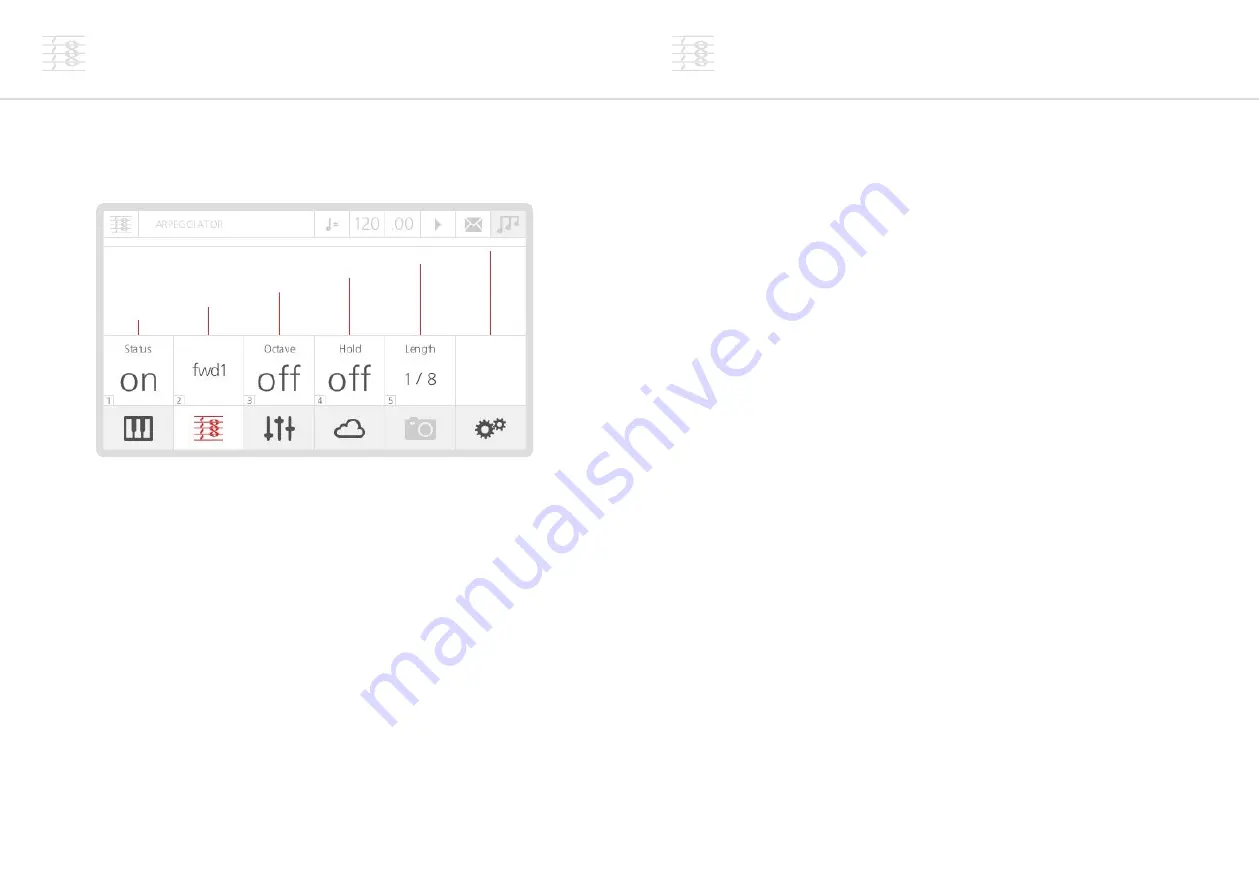
50
51
Arpeggiator
When the arpeggiator page is shown on the LCD, the first 5 LEDs on the first row of
the sequencer encoders light up in red, indicating the knobs you can use to control the
arpeggiator parameters.
1. Status:
this parameter activates the arpeggiator.
2. Mode:
allows you to set the direction mode of the sequence. The available options are
similar to those of the Sequencer (see Arpeggiator modes).
3. Octave:
if this option is on, the arpeggiator will always repeat each note twice with the
second note one octave higher, e.g. if playing C3-E3-G3-B3 in ‘Forward’ mode (see later),
you will have C3-C4-E3-E4-G3-G4-B3-B4-C3-C4-E3...
4. Hold:
if this option is off, you need to hold the keys down to include notes into the
arpeggiated sequence (i.e. if you are playing a chord and you leave just one key, the
arpeggiator removes that from the sequence, but will keep playing the remaining notes).
Alternatively, if this option is on, you can insert new notes in the sequence without
holding the keys down and then remove them by pressing the same keys again. This is a
unique feature of the 001, and allows you to easily access other parameters of the synth
while the arpeggiator is running, as well as have more control over the pattern of notes,
similar to a full sequencer.
5. Length:
this parameter controls the step length of the arpeggiator, expressed in beat-
divisions. This means that the length of each repeated note will be calculated accordingly
to the current ‘Tempo’ value (expressed in BPM).
At the moment, the ‘Gate’ of the arpeggiator is set at a default value of 50% (i.e. the
release phase of the envelopes actually starts at half of the step length value).
Modes
In this section we are going to explain the different modes available for the Sequencer, the
Animator and the Arpeggiator.
From now on, ‘pressed-order’ means the order in which you played the notes; on the other
hand, ‘note-order’ means the keyboard ascending/descending order, no matter which notes
you pressed first (i.e. this is the standard meaning of ‘order’ for classic arpeggiators).
Modes ‘fwd1’, ‘bck1’, ‘pen1’, ‘pen2’, ‘shuf’ and ‘rand’ are available for both the Sequencer,
the Animator and the Arpeggiator. Modes ‘fwd2’, ‘bck2’, ‘pen3’ and ‘pen4’ are available for
the Arpeggiator only.
As an example, let’s take a sequence of notes in this order G-C-B-E:
•
Forward1 (‘fwd1’):
the arpeggiator repeats the notes in the same pressed-order
i.e G-C-B-E-G-C-B-E-G...
•
Backward1 (‘bck1’):
the arpeggiator repeats the notes in inverse pressed-order
i.e. E-B-C-G-E-B-C-G-E...
•
Pendulum1 (‘pen1’):
the arpeggiator repeats the sequence forward then backward,
playing the first and last notes twice
i.e. G-C-B-E-E-B-C-G-G-C-B...
•
Pendulum2 (‘pen2’):
like Pen1, but without repeating the first and last note of the
sequence
i.e. G-C-B-E-B-C-G-C-B-E-B...
•
Shuffle (‘shuf’):
the arpeggiator generates a random pattern (i.e. a new note order) as
long as the number of pressed notes, then it repeats that pattern
i.e. B-E-G-C-B-E-G-C-B-E...
•
Random (‘rand’):
completely random pattern
•
Forward2 (‘fwd2’):
like Forw1, but in note-order
i.e. C-E-G-B-C-E-G-B...
•
Backward2 (‘bck2’):
like Back1, but in note-order
i.e. B-G-E-C-B-G-E-C-B...
•
Pendulum3 (‘pen2’):
like Pen1, but in note-order
i.e. C-E-G-B-B-G-E-C-C-E...
•
Pendulum4 (‘pen4’):
like Pen2, but in note-order
i.e. C-E-G-B-G-E-C-E-G...






























